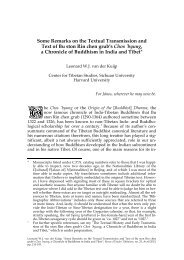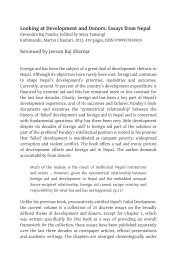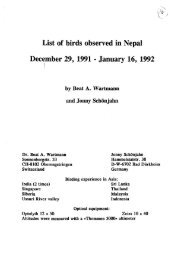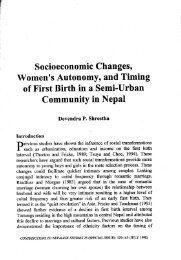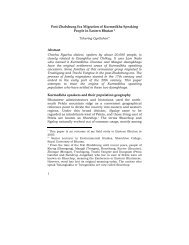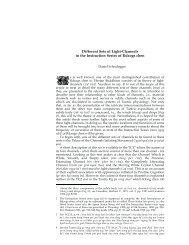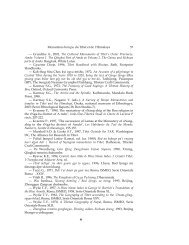Create successful ePaper yourself
Turn your PDF publications into a flip-book with our unique Google optimized e-Paper software.
Legal Eye<br />
36<br />
Objection Overruled<br />
Appointments of Anup Raj Sharma and Balram K.C., none of them<br />
Appellate Court judges, to the Supreme Court Bench have come under<br />
fire from the establishment. But Sharma and K.C. both have solid<br />
track records and the judiciary has to free itself from conventional<br />
trappings if it is to establish meritocracy in its ranks<br />
BY JOGENDRA GHIMIRE<br />
It’s not just the country’s executive, or absence of one, that is in the<br />
news. Recently, there has been some controversy over the appointment<br />
of two senior practicing advocates—Anup Raj Sharma and<br />
Balaram K.C.—as the judges of the Supreme Court. The appointment of<br />
practicing lawyers to the highest Bench is a rather rare happening in our<br />
judiciary, which is used to promoting career civil servants and career<br />
judges right up to the highest echelons. In the past, such appointments<br />
have been fairly low-key affairs since the constituency<br />
that was directly affected by such<br />
appointments—the Appellate Court judges,<br />
the senior members of the Bar and eligible<br />
academics—generally kept silent over such<br />
appointments.<br />
The two recent additions to the Bench,<br />
however, have disturbed the ranks, especially<br />
the Appellate Court justices, so much that they<br />
have gone so far as to petition the King against<br />
the appointments. The outrage is palpable.<br />
Their criticism revolves around a few points.<br />
The duo were junior compared to a number<br />
of sitting Appellate judges; and, that appointment<br />
of Sharma directly as a permanent judge<br />
without having served as an ad hoc judge,<br />
the route most judges in the apex court normally<br />
take, is a deviation from a time-honored<br />
tradition.<br />
These arguments are limp. The judiciary<br />
has to free itself from bureaucratic trappings,<br />
if it is to establish meritocracy in its ranks.<br />
Both Sharma and K.C. have great track<br />
records—Sharma as a successful commercial<br />
lawyer and K.C. as a government prosecutor<br />
and, since his retirement from the government, as a litigator and<br />
arbitrator of repute. They are undoubtedly among the brightest members<br />
of the Bar and have a sound understanding of Nepal’s judicial system.<br />
Indeed, they are junior to some of the judges in the Appellate Court.<br />
But those who say they have greater claims, and not Messrs K.C. and<br />
Sharma, to the Supreme Court based on their seniority are ignoring<br />
perhaps the most important underlying philosophy. That of the Constitution,<br />
which provides no guarantee to appointments to the apex court<br />
based on seniority. It is not a process of natural progression.<br />
Sharma and K.C. are only two of the 10 individuals who have been<br />
appointed as permanent or ad hoc justices of the apex court during the<br />
last two lots of appointments. Every other individual who has been appointed<br />
as an ad hoc judge or confirmed as a permanent judge was from<br />
among the Appellate judges. Considering that a far fewer number of<br />
lawyers who get appointed to the apex court compared to sitting judges<br />
of the Appellate Courts, the obvious question before us is: what was so<br />
different about these appointments that outraged the Appellate judges<br />
so much?<br />
This reaction can be best understood<br />
keeping in view most of the post-1990 appointments,<br />
which seem to have created an<br />
impression that the apex court positions were<br />
the preserves of the career judicial officers<br />
and lower court judges. This seems to have<br />
given credence to the conventional theory<br />
that those from outside the Appellate Courts<br />
essentially come in to bite off chunks from<br />
the pie—to borrow an expression used recently<br />
by a retired Supreme Court justice,<br />
Krishna Jung Rayamajhi.<br />
The tendency to take the easy route by<br />
appointing the seniormost of the Appellate<br />
judges to the apex court has been doubly<br />
retarding. It makes the Apellate judges professionally<br />
complacent; it also frustrates far<br />
more capable lawyers and judges in the lower<br />
courts who don’t have a shot at the Supreme<br />
Court Bench despite their competence.<br />
The fundamental problem lies with the<br />
twin issues of seniority and service with the<br />
government—both against the letter and spirit<br />
of the Constitution. We have been obsessed<br />
with the idea of appointing the seniormost of<br />
the Appellate judges to the Supreme Court without actually looking into<br />
the competence of the individual under question.<br />
The Constitution, in fact, looks for neither the seniormost individual,<br />
nor for an Appellate judge. What it looks for are competent<br />
jurists who have either been an Appellate judge for at least 10 years<br />
or have been practicing lawyers or law researchers for at least 15.<br />
Beyond this, it is purely individual competence that ought to be the<br />
deciding factor—not seniority or X number of years one has put in<br />
government service.<br />
MAY 30, 2004 | nation weekly






